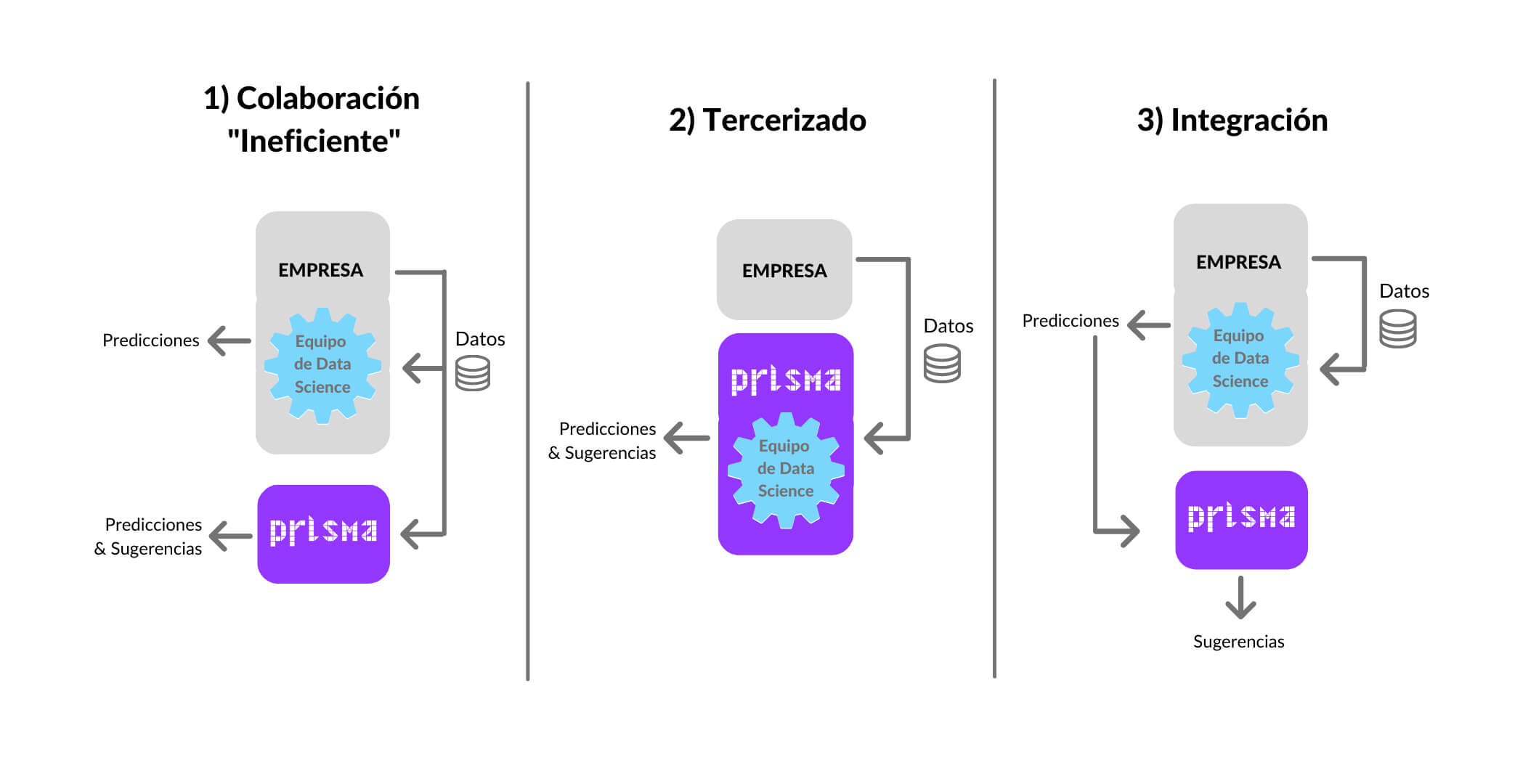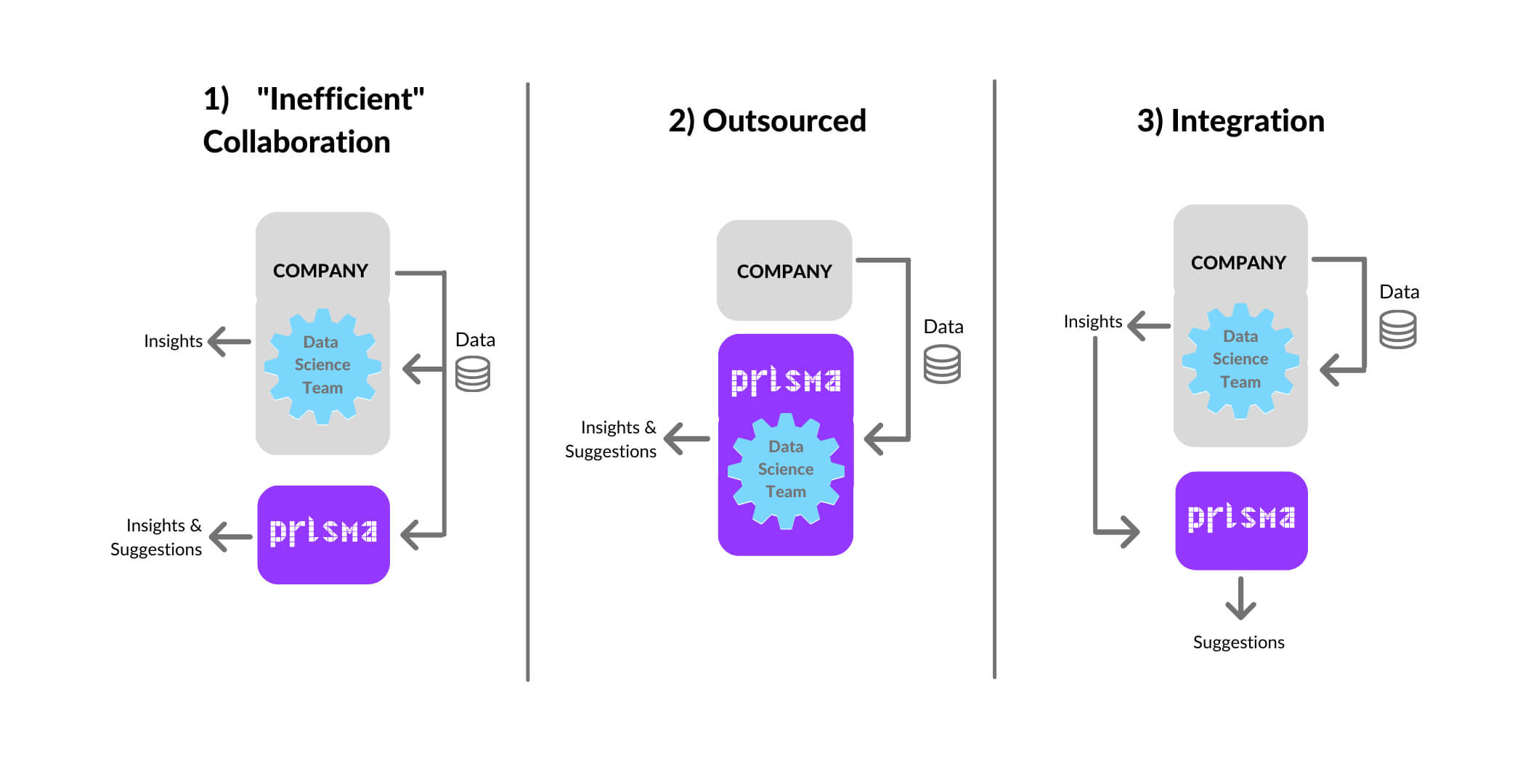How to extract the most value from your retail data
- Nowadays, companies have a countless amount of data to process, both internal and external. The secret lies in analyzing the data correctly and making the right business decisions.
- However, there are companies that fail in the analysis of their information because they do not have the right tools, technical expertise, time or resources required for the development of data science.
- Also, there is a concern and resistance to acquire external solutions, mainly due to the fear of sharing confidential information with third parties.
- As far as data science teams and optimization tools, they are on every company's investment “wishlist” and roadmap. Today, we are witnessing a similar situation to what happened some time ago when chose the path of in-house development of ERP or CRM systems. Later on, they realized that it is more efficient and less expensive to invest in external solutions created by companies that are specialized in the field, allowing them to focus on improving their core business.
- On the other hand, there are companies that do not have powerful analytical tools and therefore find it difficult to obtain more value from their data. Or are used to working with popular “low cost” tools such as Excel and are resistant to change.
- Here are three scenarios for data science management we will be reviewing:



Inefficient collaboration.
- There are companies that decide to create their own in house Data Science team to generate predictions while they maintain full "control" of the information. Likewise, another department or business category operating as an independent unit may decide to acquire an external solution that analyzes data and makes predictions, suggestions and generates reports to enable decision making.
- In this first scenario, the two parties work separately although they share a common objective. That is, both parties perform the data collection and analysis, but fail to strengthen their skills by leveraging joint efforts. In this scenario, the external solution fails to enhance the data scientist's tasks to a 100%.
Outsourced.
- In this case, companies choose to acquire a solution dedicated to the optimization of key retail variables to generate predictions and suggestions based on internal and external data.
- It is an excellent alternative for companies with limited resources. The outsourced services and tools are specialists in their field, and are constantly analyzing and improving their solutions to offer the latest technology. Delivery and implementation times are usually around 3 to 6 months, which allows companies to start working quickly. In turn, the company will be able to dedicate their resources to the core business and avoid losing their strategic focus.


Integration.
- In the third scenario, the company has an area dedicated to data analysis but also acquires a solution that works with them to strengthen the role of Data Scientists.
- The Data Science team can focus on data collection while the external solution performs an analysis of the business and its context. Together they work on developing the best algorithms and practices for the business.
- Companies leverage the predictions and suggestions generated by the optimization solution while having an overall perspective of the business.
- With the right data analysis, companies will be able to understand their clients and acquire new customers, while improving operational efficiency, reducing costs and optimizing profitability. Artificial intelligence can behave as a central nervous system, reading signals, reacting to events and anticipating future outcomes. For this purpose, it is ideal to have an in house or outsourced Data Science team integrated with an optimization solution.
- Prisma is an omnichannel solution that analyzes, predicts and suggests actions that increase your profitability through the combined optimization of Prices, Assortments, Promotions, Spaces and Inventories. It integrates the data collected from internal and external sources, and works closely with the Data Science Teams to develop new algorithms/practices focused on retail optimization.
- Our business experience tells us that having an in house or outsourced data science team that receives insights and suggestions from an external solution - is the best combination for business optimization.

You may also be
interested in.
Marketing Team
Top 5 AI algorithms applied in retail
In the following Blog post we will analyze what Data Science is and what are the Top 5 algorithms applied in retail today.
Marketing Team
Are dark stores the future of retail?
In the United States, as a result of the pandemic, retailers were forced to expand their business through ecommerce, increasing the trend towards the creation of 'Dark Stores'.
Marketing Team
The 4 omnichannel challenges that retailers must solve
The current pandemic has retailers looking for investments to deliver an efficient omnichannel experience.
Marketing Team
Goodbye 2020: top 5 lessons you leave behind.
2020 has been a difficult year full of challenges for everyone. But it has left behind a series of learnings that every retail company should consider adding to 2021 strategic planning.
Victoria Hearne
Is your pricing strategy not working? These could be the 4 reasons
Choosing a pricing strategy is one of the biggest challenges for any business, as it is the result of complex calculations, research, understanding, and the ability to take risks.
Gustavo Sappia
Leading Colombian pharmacy chain implements Pricing and Space Planning modules
One of the leading pharmacy chains in Colombia, owning 960 stores nationwide and selling more than 20,000 products, pursued a digital transformation that would allow coping with typical retail problems and increasing its profitability.
Lucas Migliano
Common Retail Tech implementation objections
Let’s face it, all companies need to transform themselves in some part of their life cycle, however this doesn’t mean that implementing a new software or a new process should be easy.
Micaela M. Kulesz
COVID-19:
Let's buy it all NOW!
Fights, despair, anxiety, and many other emotions are being exposed in retail stores nowadays. We all have seen images and videos of consumers stocking (or stalking?) toilet paper and other goods in most countries hit by the COVID-19, suggesting the apocalypse of basic goods.
Micaela M. Kulesz
“Canastas de Alimentos” : listas para comprar en un solo click
Con el comienzo de la cuarentena sobrevinieron importantes cambios de hábitos en el comportamiento del consumidor. La principal tendencia observable, es la manera en que el comercio online fue ganando terreno por sobre las tiendas físicas.
Lucas Gorganchian
Price Perceptions, Consumer Choices and the Compromise Effect
António Damásio, in his book “Descartes' Error,” states that emotions both guide and bias behavior and decision-making. One of the examples he uses is called the Compromise Effect, a behavioral phenomenon by which customers often choose the mid-priced option to protect themselves from making a bad choice.
